#Sabal Palm Trees
Text

into the blue
#palm tree#tree#nature#photography#film photography#film#shot on film#expired film#summer#canon#sabal palmetto#cabbage palm#sabal palm tree
6 notes
·
View notes
Text
when was the last time you saw a weevil this big
The largest weevil in North America, the palmetto weevil (Rhyncophorus cruentatus) lays eggs in the crowns of palms, where the grubs feed and often kill their host in the process.
In Florida it’s considered a major pest due to its habit of destroying ornamental palm trees, but native palmettos and sabal palms (the weevils’ natural hosts) are rarely harmed unless they’re already stressed or damaged. It’s mostly date palms and other exotic species planted along city streets that can’t take the heat and need to be drenched with insecticide to ensure survival.
(Florida, 10/31/23)
5K notes
·
View notes
Text

Which are the most common palm trees in the world?
In different regions of the world, there are several different varieties of palm trees that can be found. It depends upon the climatic conditions of the region. The most commonly found palm trees include the Areca palm tree, royal palm tree, Pygmy Date palm tree, and coconut palm tree. Order your favorite palm on jmclandscapingfl.com today!
1 note
·
View note
Text

Sabal Palm Tree for TS3 and CAW
Download here
The sabal palm, or cabbage palm, is the official state tree of Florida. It's right at home in the sunshine state - it loves hot and humid conditions, and fares especially well in hurricanes.
I had to forgo some details, like the bootjacks that typically cover a young sabal's trunk, due to limitations. But the silhouette cast by this model still feels unmistakably Floridian to me :)

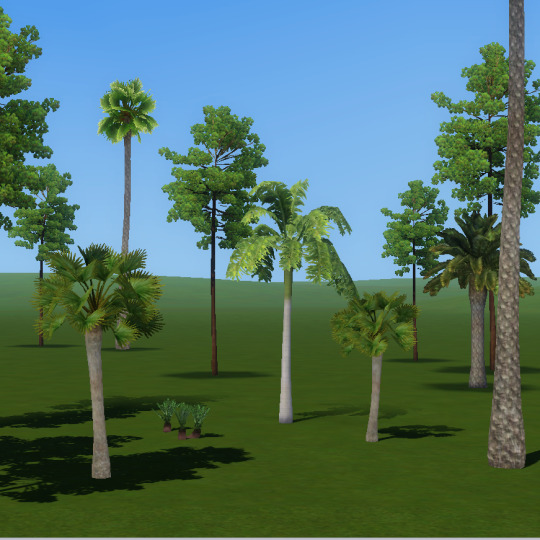
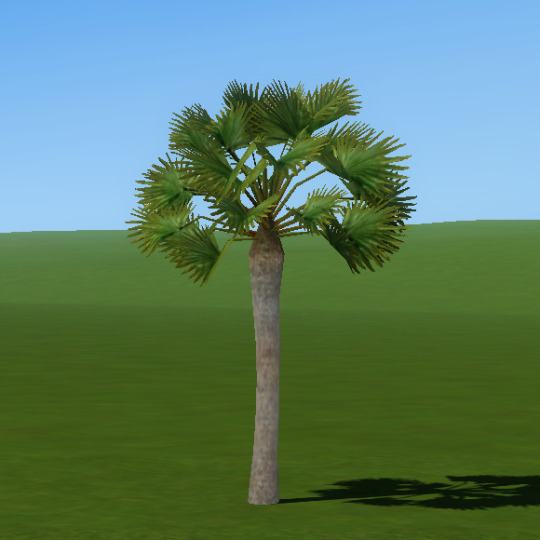
Price: §335
Category: Trees & Plants; CAW; Edit Neighbourhood
Name: LdnS Sabal Palm
Base game compatible / .package file
TOU:
Go crazy, include with your world/lot, adapt it to your tastes, steal my textures, etc.
If you create a plant cloned from this, make sure it is unique and not a default replacement - this can’t be done to speedtree plants in the usual way with s3oc alone but I have a guide here to do it. And please link back to my blog when you share :)
58 notes
·
View notes
Text
#1931 - Cordyline australis - Cabbage Tree
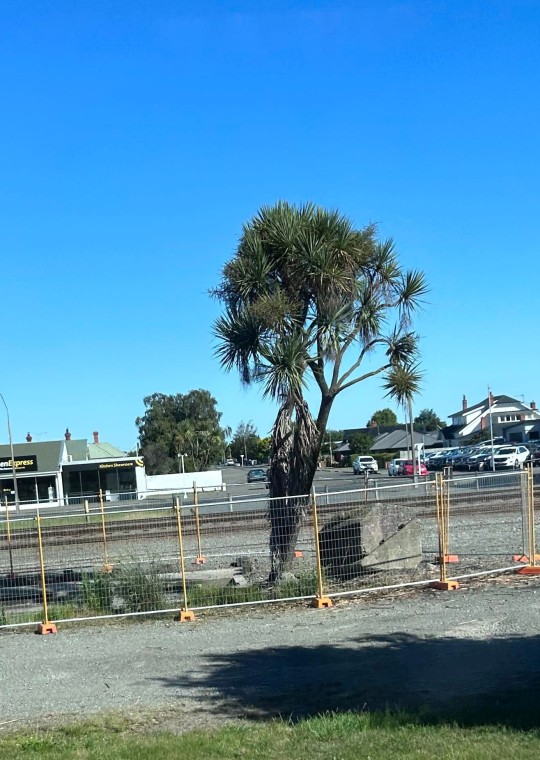

AKA tī kōuka or cabbage-palm. Originally Dracaena australis, when it was described by Georg Forster in 1786, after Joseph Banks and Daniel Solander collected some in 1769.
Another of Aotearoa’s most iconic plants. The binomial refers to the shape of the rhizomes - club-like - and the southern distribution. The common name name is likely down to Georg Forster again, writing in his Voyage round the World (1777) who discusses the edibility of the central shoot in comparison to the ‘true cabbage palm’ - probably the cabbage palmetto (Sabal palmetto) of Florida.
It’s certainly edible - not only do a wide variety of New Zealand native fauna love the stuff, the Māori cultivated it for the rhizomes and growing shoots. The meter-long leaves were also collected for the very strong fibres they contained, which were used as rope and as protective capes and legwear when travelling anywhere Matagouri and Spaniard Grass grows. You’ll recall those from earlier posts - protective legwear is strongly recommended.
The Cordylines of NZ were probably derived from an influx of tropical plants some 15 million years ago, and promptly diversified. They certainly thrive in cool climates much better than similar-looking plants - they’re now grown as far north as Scotland, and one common name in use in the UK is Torquay Palm.
A healthy Cabbage Tree can be as tall as 20m, but there’s not many of those left. That’s partly down to land clearance, Rural Decline where a lone Cabbage Palm that was lucky enough to be left behind by land clearance is slowly killed by livestock and rabbits, and Sudden Decline caused by the bacterium Phytoplasma australiense, which may be spread from tree to tree by the introduced passionvine hopper from Australia.
6 notes
·
View notes
Photo
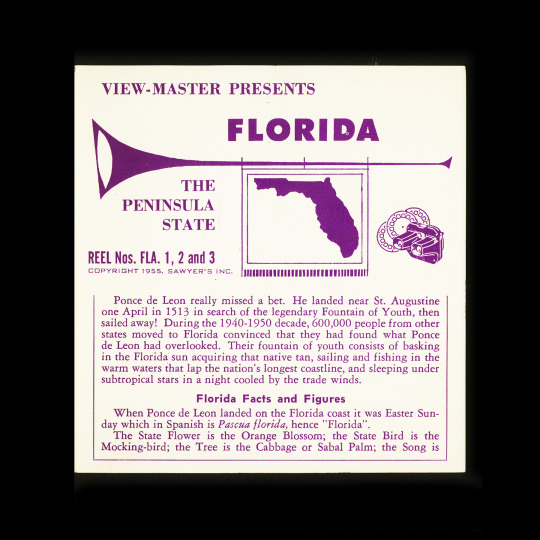
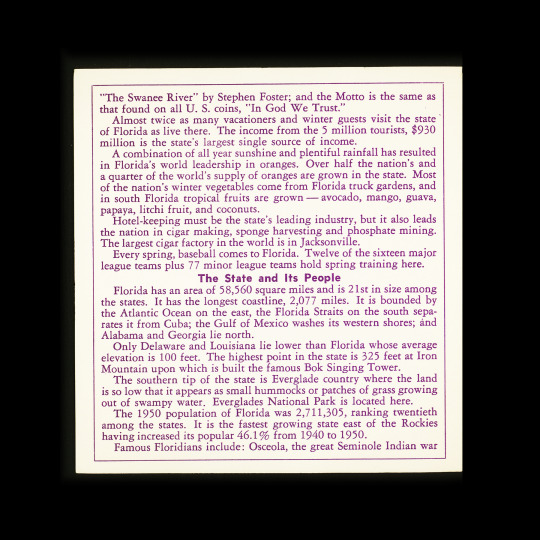

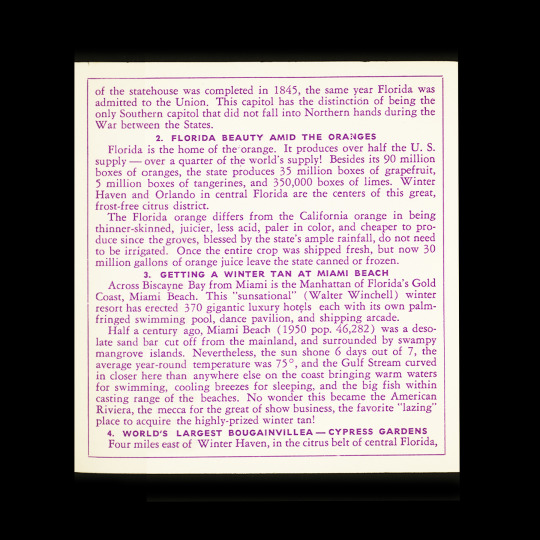

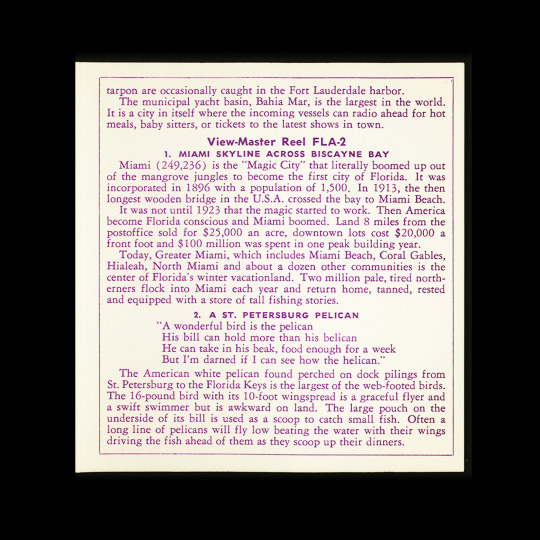




Brand: View-Master
Packet Title: Florida
Booklet Title: View-Master Presents Florida
Booklet Subtitle: The Peninsula State
Date: 1955
Note: When reading the booklet descriptions, please remember that these booklets are old (most are 65+ years old) and the information and history presented in them as factual may be inaccurate, outdated, and in some cases, offensive.
Booklet Introduction Description:
Ponce de Leon really missed a bet. He landed near St. Augustine one April in 1513 in search of the legendary Fountain of Youth, then sailed away! During the 1940-1950 decade, 600,000 people from other states moved to Florida convinced that they had found what Ponce de Leon had overlooked. Their fountain of youth consists of basking in the Florida sun acquiring that native tan, sailing and fishing in the warm waters that lap the nation's longest coastline, and sleeping under subtropical stars in a night cooled by the trade winds.
Florida Facts and Figures
When Ponce de Leon landed on the Florida coast it was Easter Sunday which in Spanish is Pascua florida, hence "Florida".
The State Flower is the Orange Blossom; the State Bird is the Mocking-bird; the Tree is the Cabbage or Sabal Palm; the Song is "The Swanee River" by Stephen Foster; and the Motto is the same as that found on all U. S. coins, "In God We Trust."
Almost twice as many vacationers and winter guests visit the state of Florida as live there. The income from the 5 million tourists, $930 million is the state's largest single source of income.
A combination of all year sunshine and plentiful rainfall has resulted in Florida's world leadership in oranges. Over half the nation's and a quarter of the world's supply of oranges are grown in the state. Most of the nation's winter vegetables come from Florida truck gardens, and in south Florida tropical fruits are grown - avocado, mango, guava, papaya, litchi fruit, and coconuts.
Hotel-keeping must be the state's leading industry, but it also leads the nation in cigar making, sponge harvesting and phosphate mining. The largest cigar factory in the world is in Jacksonville.
Every spring, baseball comes to Florida. Twelve of the sixteen major league teams plus 77 minor league teams hold spring training here.
The State and Its People
Florida has an area of 58,560 square miles and is 21st in size among the states. It has the longest coastline, 2,077 miles. It is bounded by the Atlantic Ocean on the east, the Florida Straits on the south separates it from Cuba; the Gulf of Mexico washes its western shores; and Alabama and Georgia lie north.
Only Delaware and Louisiana lie lower than Florida whose average elevation is 100 feet. The highest point in the state is 325 feet at Iron Mountain upon which is built the famous Bok Singing Tower.
The southern tip of the state is Everglade country where the land is so low that it appears as small hummocks or patches of grass growing out of swampy water. Everglades National Park is located here.
The 1950 population of Florida was 2,711,305, ranking twentieth among the states. It is the fastest growing state east of the Rockies having increased its popular 46.1% from 1940 to 1950.
Famous Floridians include: Osceola, the great Seminole Indian war chief who was never defeated but finally tricked into imprisonment; John Gorrie, of Apalachicola, inventor of mechanical refrigeration; Marjorie Kinnar Rawlings, whose Pulitzer prize novel, The Yearling” dealt with the Florida backwoods; and Joseph W. "Vinegar Joe" Stilwell, commander of the China-Burma-India Theater of War.
Highlights of History
After discovering Florida, Ponce de Leon landed two shiploads of colonists at Charlotte Harbor in 1521, but constant clashes with the Indians resulted in his death and the abandonment of the colony.
Tales of fabulous cities of gold (which were not to spring up until the 20th century) lured other Spanish explorers. Hernando de Soto landed in the Tampa area in 1539 to begin a four year march.
Don Pedro Menendez de Aviles, Captain General of the Spanish treasure fleets, came to Florida in 1565 to found St. Augustine and a line of posts from Tampa Bay to Port Royal, South Carolina.
After the British captured Havana, Cuba, in 1763, Spain agreed to trade Florida for the Cuban capital. But after the American Revolution, the British were squeezed in by the new United States and Spanish strongholds to the south. They ceded Florida to Spain from whom the United States bought it in 1819 for $5 million.
With the creation of the Florida Territory in 1822 came Indian trouble. The Seven-Year Seminole Wars ending in 1842 cost the lives of 1,500 American soldiers but brought eventual peace paving the way for statehood which was granted on March 3, 1845.
3 notes
·
View notes
Text
which palm tree would you like. we have the sabal palm. the blue bismarck palm. the christmas palm. the date palm. the pygmy date palm. the banana palm. the coconut palm. the
3 notes
·
View notes
Text
Climate of Florida
Florida's climate is indeed quite diverse, with distinct tropical and subtropical regions. The delineation between these regions is marked by a west-east line from Bradenton along the south shore of Lake Okeechobee to Vero Beach. South of this line lies the tropical zone, characterized by warmer temperatures and lush vegetation, while north of it, the state transitions into a subtropical climate.
See Weather Forecast for Florida today: https://weatherusa.app/florida
Summers are consistently warm throughout Florida, with temperatures averaging in the 80s °F (27 to 29 °C). However, even in Miami, freezing temperatures can occur, albeit rarely and of short duration. The Keys, due to their southernmost location, have never experienced frost.
Rainfall patterns in Florida are heavily influenced by the summer months, with the heaviest precipitation occurring during this time. The average annual rainfall varies from around 40 inches (1,000 mm) in Key West to 62 inches (1,575 mm) in West Palm Beach. Snowfall is infrequent but can occur in northern areas, with reports extending as far south as Miami. See more: https://weatherusa.app/zip-code/weather-32978
The west coast of Florida is particularly susceptible to lightning strikes during the summer, while hurricanes pose a recurring threat to the state, with about one striking annually on average. The hurricane season spans from June to November, with September being the most likely month for hurricanes to occur. Notable hurricanes in Florida's history include the devastating Great Hurricane of 1928 and Hurricane Andrew in 1992.
Average annual temperatures in Florida exhibit minimal variation, ranging from around 68 °F (20 °C) in Tallahassee in the north to 77 °F (25 °C) in Key West in the south. Monthly averages in January range from the mid-40s °F (6 to 8 °C) in the north to the mid-50s °F (12 to 14 °C) in the south, while August sees temperatures in the lower 80s °F (27 to 29 °C). These consistent temperatures contribute to Florida's appeal as a year-round destination for tourists and residents alike.
See more: https://weatherusa.app/zip-code/weather-32931
https://weatherusa.app/zip-code/weather-32816
https://weatherusa.app/zip-code/weather-32927

Florida boasts a remarkable diversity of plant and animal life, owing to its rich array of ecosystems and favorable climate. The state is home to thousands of plant species, including several hundred trees, many of which thrive in its extensive forested areas covering approximately half of its territory.
In Florida's forests, dominant tree species include pines, oaks, cypresses, palms, and mangroves, with tropical trees flourishing in the southern regions and temperate varieties such as beech, red maple, sweet gum, tulip (yellow poplar), magnolia, and hickory being common in the north. Nearly half of the tree species found in the United States can be found in Florida.
See more: https://weatherusa.app/zip-code/weather-32814 The state's vegetation varies according to soil type, with different plant communities thriving in different regions. For example, flatwood lowland areas are characterized by slash and longleaf pine, oak, sabal palm, and grasses, while organic soils support sawgrass, cypress, sabal palm, myrtle, willow, elderberry, and gum. In limestone regions, grasses, saw palmettos, and sabal palms predominate, with cypress, bay, and gumbo-limbo trees being characteristic of extreme southern areas. Northern upland soils support hardwoods like loblolly and longleaf pine.
Florida's diverse habitats support a vast and varied wildlife population, including rare and protected species such as crocodiles, manatees, and the Florida panther. The state is home to around 100 species of mammals, including deer, pumas, bobcats, black bears, armadillos, otters, mink, and gray foxes, alongside numerous smaller animals. Manatees are commonly found along the coast and in warm inland waters, while various species of porpoises and dolphins inhabit the coastal waters. See more: https://weatherusa.app/zip-code/weather-32735
Over 400 species and subspecies of birds have been documented in Florida, including land birds such as turkeys, quail, eagles, and hawks, as well as aquatic species like gulls, pelicans, and ospreys. Freshwater and marsh regions are home to birds such as ducks, geese, egrets, herons, and ibises. The state's reptile population includes the iconic alligator, along with more than 40 species of snakes, turtles, tortoises, lizards, and frogs.
Florida's extensive waterways harbor hundreds of species of fish and shellfish, including saltwater varieties like bluefish, snappers, groupers, and shellfish such as crawfish, oysters, crabs, clams, and shrimp. Freshwater species include the largemouth black bass, bream, sunfish, speckled perch, and catfish. Overall, Florida's biodiversity and abundance of wildlife contribute significantly to its ecological importance and its appeal to nature enthusiasts.
See more: https://weatherusa.app/zip-code/weather-32733
https://weatherusa.app/zip-code/weather-32708
https://weatherusa.app/zip-code/weather-32328
0 notes
Text
[WIP] Intro to Bromeliads: Surprising Tropicals for the Zone 9a Garden
Bromeliads are a special family of flowering plants from the Americas that have many adaptations for low-water including CAM-photosynthesis (like cacti). Some are terrestrial like your typical plant but others are able to grow on trees and rocks, scientifically known as “epiphytic” and “lithophytic” respectively. Many bromeliads are great both for beginner gardeners and snobs (me) alike.
Bromeliad categories:
Dyckia & Succulent - Dyckia, Puya, Hechtia, Encholichreron are (somewhat) common genera in circulation these are the bromeliads tend to be more terrestrial or lithophytic, growing in low rainfall areas kind of like an agave or a standard cactus
Airplant - Tillandsia species - these are often wispy plants which gather water from special hairs on their leaves rather than roots which gives them usually a silvery appearance. Airplants are found from South America into the mid-Atlantic USA in a variety of habitats with some even growing on cacti in deserts such as the fragrant and quite large Tillandsia duratti.
Tank & Urn broms aka “classic broms” - common genera are Neoregelia, Aechmea, Billbergia, and Vriesea, these are the popular idea of a brom, plants with stiff leaves that often store water in their centers (known as the “tank”) most of these are native to tropical and subtropical forests in Central and South America.
Note on Hardiness:
For all marginal plants, especially “tank” bromeliads and mounted plants, the rule of thumb is to provide oak canopy or a similar reliable, evergreen cover. This is crucial in climates like Deep South where freezes typically are short in duration, occurring briefly during cloudless nights in winter. The oak canopy functions as a blanket for the plants and keeps the cold (which comes from above!) setting in and potentially also keeping any morning dew from freezing into frost. Bromeliads cope much better with “dry cold”. London is zone 9 just like my area, I’ve visited and seen our native Cabbage palms growing big in London, but they cannot grow half the bromeliads we can. This is because the UK has a wetter and longer-lasting cold. [If you are in UK reading this: look on inat at Tillandsia species growing in Argentina and at Aechmea recurvata].
Photo caption: A collection of bromeliads underneath a native Sand live oak (Quercus geminata)
Photo caption: Billbergia nutans mounted to a Southern live oak, this patch has endured temperatures of 23F and several nights in mid-20s after that. It gets no irrigation or fertilizer.
Siting Bromeliads:
Most bromeliads grown are from humid forests where they evolved to grow on trees. Dappled shade and part sun conditions are almost always best for them for this reason. As mentioned above, the canopy cover is also important to protect the plants from extremes in weather temperature.
If growing in the Southeast, you tend to not have to worry about increasing humidity but I also find localized areas of increased humidity benefit bromeliads and other epiphytes.
Examples of increased humidity areas in my garden:
Tree over a paved surface (water evaporating off paved surface)
Near an air conditioner (these drip out water all day)
Over my small frog pond
Look for lichens and other epiphytes as evidence of suitable areas for humidity-lovers.
Bromeliads that can be grown both terrestrially and epiphytically are perfect for areas of dry shade/high root competition such as at base of native Cabbage palm or particularly thirsty trees like my Red maple.
Caption: A bed with extreme root competition at base of native Red maple (Acer rubra) and Cabbage palm (Sabal palmetto) featuring many bromeliads.
Mounting bromeliads
I recommend using aluminum wire or a natural twine for mounting bromelaids where needed. Plastics like synthetic rope and fishing lines are dangerous to wildlife and, especially synthetic fibers, degrade into microplastics and nanoplastics which are so small they can cross the blood-brain barrier (if you wouldnt bite into a credit card, you shouldnt be using that stuff basically).
Sometimes with the bromeliad shape you can get by just putting it on and using Beard airplant wrapped around it. Some also use wood glue but it is important not to cover too much of the plant if it is an airplant as the plant needs to get water through its leaves.
Bromeliads and other epiphytes including orchids tend to favor the following characteristics:
Furrowed bark (easiest to grab onto)
Evergreen canopy (protects from temperature extremes)
“Leakiness” (tree releases more minerals than average = more fertilizer for epis!)
Live oaks satisfy all three of those characteristics which is why they are draped in beard airplants in the Deep South.
Cypress are also “leaky” and favored by airplants but they do not have furrowed bark nor are they evergreen so outside of zone 10b+ they are not as good for marginal species.
If you are unable to have a full-sized Live oak, I recommend the extremely under-utilized small native oak species Quercus myrtifolia (the record largest is 39 feet but typically they are shorter than two storeys). For reference, the common as sin Japanese Waxleaf privet is a much bigger plant than this and much quicker in growth rate yet I also see it planted right next to houses. You also could try a native holly like the Dahoon or a Weeping yaupon and keep them as small trees.
As far as exotics go, Bottlebrush has furrowed bark and I can recommend it for all day sun to part sun conditions. For no more than 8 hours of sun, Pineapple guava is great but it does have flaky bark so attachment may not occur.
Good Beginner Tank Broms:
Androlopsis skinneri 'Paradise', very nice huge brom for warmer zone 9a
Aechmea caudata, e.g. 'Santa Catarina' perhaps my favorite of the established zone 9a species
Aechmea disticantha warning that it is a vicious bastard of a plant, but probably the hardiest of the larger Aechmea species to my knowledge
Aechmea recurvata
"matchstick" bromeliads e.g.
Aechmea apocalyptica
Aechmea cornata
Aechmea cylindrata
Aechmea gamosepala (probably the most common)
Aechmea x 'Burgundy' hybrid with disticantha parentage but much smaller and less vicious with good foliage color
Billbergia nutans
Other Billbergia hybrids might be hardy as well, a plant that appears to be the cultivated hybrid 'Hallelujah' bloomed through 3 days of mid-20s night temps under oak in a very sheltered location (notably firebush in same area was of course knocked to the ground).
Many Neoregelia hybrids, at work the following had little to no damage during mid-20s:
Neoregelia Cruenta
Neoregelia Super Fireball
Noid that lookes like Neoregelia Raphael
Noid that looks like Neoregelia ___
Nidularium innocentii
Androlopsis x Aechmea disticantha = O'Rourke very nice intergeneric likely hardier than Androlopsis parent thanks to disticantha but this also makes it a bit more brutal to handle than Androlopsis
Airplants for zone 9a:
Showy species native to North FL
Tillandsia bartramii
Tillandsia x floridana
Tillandsia usenoides aka "Spanish moss" (i call beard airplant)
South TX Tillandsia baileyi
"Southern Cone" airplants such as:
Tillandsia aeranthos
Tillandsia albertiana
Tillandsia stricta
Tillandsia tenuifolia
Misc. species
Tillandsia ionantha
0 notes
Photo

Great price on this 2004-S Florida Silver Proof State Quarter ONLY: $7.50 Released on March 29, 2004, this is the 27th coin released in the 50 State Quarters Program and the second released in 2004. Florida, admitted into the Union on March 3, 1845, themed the coin, Gateway to Discovery. The coin highlights the 16th-century Spanish galleon, an image of a space shuttle, and a strip of land with Sabal palm trees. President William J. Clinton was in office when this legislation was signed. Three United States Mint Directors served under President Clinton's tenure; David J. Ryder of Idaho, Philip N. Diehl of Texas, and Jay W. Johnson of Wisconsin. https://www.thecoinshop.shop/state-commemorative-quarters/2004-s-florida-silver-proof-state-quarter View MORE State Commemorative Quarters https://www.thecoinshop.shop/state-commemorative-quarters StatehoodQuarters StateQuarterProgram statequarters
0 notes
Text
How to Grow Sabal uresana from Seed
Sabal uresana, commonly known as Sonoran palmetto or Mexican palmetto, is a species of palm native to the Sonoran Desert in northwestern Mexico. It is a medium-sized palm tree with a single trunk that can reach up to 10 meters in height. The trunk is covered in persistent leaf bases, and the leaves are fan-shaped, growing in a dense crown at the top of the trunk. The fruit of Sabal uresana is…

View On WordPress
0 notes
Photo

Field journal 📔 ID: Serenoa repens Common name: saw palmetto 🌴 Not to be confused with sabal palmetto, whose leaves are folded in the middle instead of flattened out, the saw palmetto is an important part of Florida’s ecology. 🌴 1️⃣ Saw palmetto is one of the plants that is “most highly used by Florida wildlife,” providing for more than 300 insects, butterflies, bees, flies, and beetles. 2️⃣ Saw palmetto is an important player in the fire ecology that Florida’s habitats have adapted to. If left too long without a burn, these plants can become a severe fire hazard. However, when fire is included in the land management, saw palmettos thrive and are some of the first plants that pop up from the ground just days after a fire. 3️⃣ Saw palmetto can live to be more than 2,000 years old. 4️⃣ Saw palmetto is a very hardy plant—it can grow in almost any lighting condition and is drought-tolerant and salt-tolerant, meaning it can be found in almost any habitat in Florida (as long as it’s not too submerged in moist soil). 5️⃣ The ethnobotanical uses of saw palmetto are numerous, with the leaves being used for thatched roofs, mats, and baskets. 🌴 *Some argue that palm trees are not technically “trees” and are instead grasses because their trunk is fibrous rather than woody. 🌱 💚 🌴 #explorida #roamflorida #florida #flstofmind #floridaliving #florida_greatshots #fun_in_florida #LoveFL #monroecounty #sawpalmetto #serenoarepens #palmtree #floridakeys #nature #naturelovers #getoutdoorsfl #southflorida #curryhammockstatepark @visitflorida @thefloridakeys @lovefl (at Curry Hammock State Park) https://www.instagram.com/p/CpyfHmCOtD4/?igshid=NGJjMDIxMWI=
#explorida#roamflorida#florida#flstofmind#floridaliving#florida_greatshots#fun_in_florida#lovefl#monroecounty#sawpalmetto#serenoarepens#palmtree#floridakeys#nature#naturelovers#getoutdoorsfl#southflorida#curryhammockstatepark
0 notes
Text
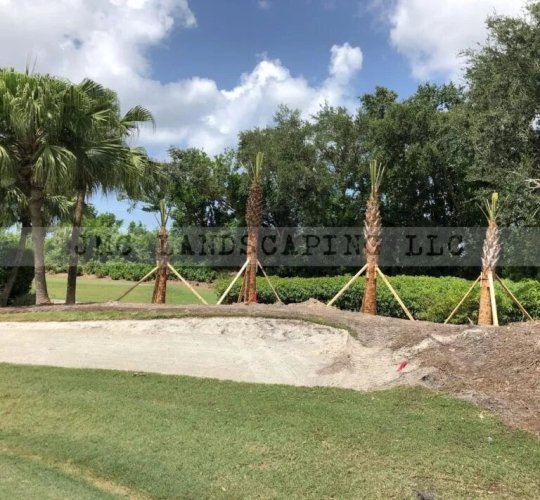
Why sabal palm is also called cabbage palm?
Among all the popular palm trees, the Sabal palm is also one. The immature leaves of the palm can be harvested as food. It is also called cabbage palm because of its texture and taste similar to that of cabbage. Call JMC Landscaping to order this palm now!
1 note
·
View note
Photo

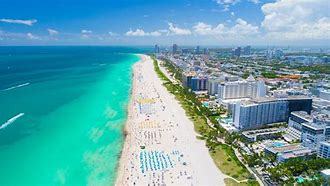
Florida state facts
Lighting capitol of the usa
crocodiles and alligators of usa
70,000 work at disney land
florida keys has about 1700 tiny island
tallahassaa state capitol
largest city is Jacksonville
state size land and water 65,755
population 21,472,737 people
state hood 3-3-1845
number of counties 67
highest point Britton HIll
length 447 miles width 361 miles
national parks biscayne, dry tortugas, everglades
state motto in god we trust
noble prize winners 1
famous people derrick brooks, tim raines, mitch richmond, william h macy
festival calle ocho open hoirse 8
song old folks at home
anthem florida where the sawgrass meets the sky
state fresh water fish florida large mouth bass
state gem moonstone
state flower orange blossom
state bird mockingbird
state marine mammal florida manatee
state slat water porpoise (dolphin)
state tree sabal palm
state wildflower state wildflower
state horse florida cracker horse
state butterfly zebra long wing
state reptile american alligator
state reptile salt water loggerhead sea turtle
state shell horse conch
stone agatized coral
0 notes
Text
Best Palm Trees for Central Florida: 7 Varieties
Best Palm Trees for Central Florida: 7 Varieties
Palm trees are the perfect addition to any outdoor living space in Central Florida. They add beauty and tropical vibes, provide shade, and bring a sense of nature into your yard. But before you commit to planting a palm tree, knowing which varieties grow best in this region is essential. This article will discuss the best palm trees for central Florida. We’ll discuss varieties such as the sabal…

View On WordPress
0 notes
Text
Hearts of palm

The arduous procedure for harvesting them is a contributing factor to the high cost of the fresh produce. They are extremely perishable when fresh and cost more than $15 per pound. Fresh hearts of palm are a rare find in most grocery stores. Once harvested, the hearts are cut and canned or packed in jars in water or a brining liquid. Ecuador and Bolivia are also top producers. Hearts of palm from multi-stemmed palm trees in Costa Rica and Ecuador are the most consumed in the world, with Costa Rica alone exporting more than 16 million pounds each year. Palm trees with only a single stem die once they’re cut and the heart is removed, whereas multi-stemmed palms regenerate every two to three years, making them a more environmentally-friendly, sustainable option. Years of over-harvesting wild hearts of palm led to regulations limiting farmers to harvesting only multi-stemmed palms on farms created specifically to grow them. The laborious harvesting process involves cutting down the trees and carefully removing the bark and other fibers until only the tender heart remains. Hearts of palm are culled from a handful of palm tree species, including the coconut, açaí and sabal palms. Today, hearts of palm grace our plates in salads, dips and a host of other dishes, including as a meat substitute for vegetarians. They are native to South and Central America, dating back to Mayan civilizations in that region. Harvested from the core of certain varieties of palm trees, hearts of palm are the tender inner stalk found at the tree’s center, or heart. Hearts of palm are a mystery to many but the path to discovering this curious vegetable begins with its name.

0 notes